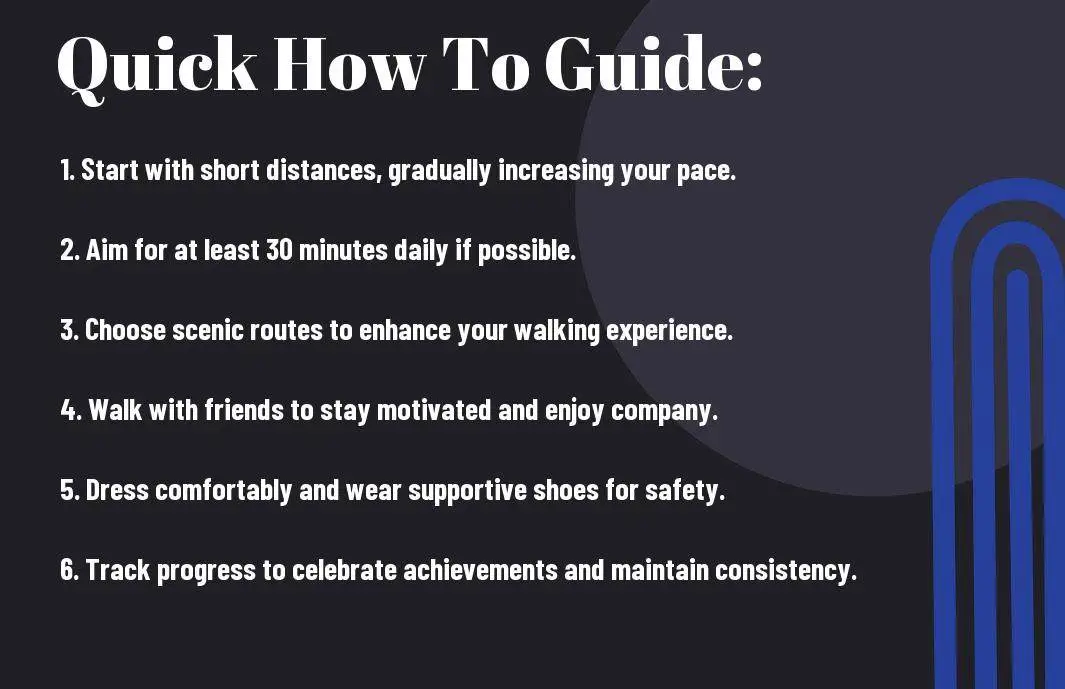The benefits of walking the simplest exercise for a healthy life
There’s no doubt that walking is one of the easiest and most accessible forms of exercise you can do to enhance your overall health. This simple activity not only improves cardiovascular fitness but also boosts mental well-being and promotes weight management. By incorporating regular walks into your routine, you can experience significant benefits such as increased energy levels, improved mood, and better joint mobility. In this post, you’ll discover why walking is an vital exercise for your health and how you can easily integrate it into your daily life.
How to Incorporate Walking into Your Daily Routine
To make walking a regular part of your life, start by setting aside specific times in your day dedicated to this activity. You can walk during lunch breaks, after dinner, or even incorporate it into your commute. Consider using a step counter or a fitness app to track your progress and keep you motivated. Creating a routine will help you seamlessly integrate walking into your lifestyle, making it a habit that you look forward to rather than an obligation.
Setting Realistic Goals
Routine is important for establishing a successful walking habit. Begin by determining how much time you can realistically allocate for walking each day. Start with shorter durations, such as 10-15 minutes, and gradually increase your walking time as you become more comfortable. Setting achievable goals allows you to track your progress, celebrate your achievements, and remain engaged without feeling overwhelmed.
Finding the Right Locations
For an enjoyable walking experience, seek out locations that inspire you. Look for parks, nature trails, or scenic streets in your neighborhood where you can connect with nature or enjoy your surroundings. Walking in pleasant environments not only uplifts your mood but also makes you more likely to stick with your routine. Whether you prefer urban settings or tranquil nature paths, find spots that resonate with you and motivate you to walk consistently.
With the right locations, your walking routine can become a delightful escape from your daily grind. Explore nearby parks, local nature reserves, or even safe sidewalks in your community. You might also consider joining a walking group, which can add a social aspect to your walks and keep you committed. Finding inspiring locations will contribute to the overall enjoyment of your walking sessions, prompting you to make it a consistent part of your health journey.
Tips for Maximizing Health Benefits
Assuming you want to make the most of your walking routine, consider these tips for optimal health benefits:
- Incorporate interval walking by alternating between brisk and casual paces
- Choose varied terrains to engage different muscle groups
- Maintain proper posture to avoid strain or injury
- Stay hydrated before, during, and after walks
- Consider setting specific walking goals to keep you motivated
Perceiving these strategies can enhance your walking experience and overall well-being.
Duration and Frequency
While aiming for health improvements, it’s typically recommended to walk for at least 150 minutes each week, broken down into manageable sessions throughout the week. This can be divided into 30 minutes a day, five days a week, helping you maintain consistency and allowing your body to adapt effectively over time.
Proper Footwear and Gear
For maximizing the benefits of your walks, investing in proper footwear and gear is crucial. Quality shoes designed for walking not only enhance comfort but also provide necessary support and cushioning.
Footwear choices should include shoes with adequate arch support, shock absorption, and a snug fit to prevent blisters. Consider moisture-wicking socks to keep your feet dry and comfortable. If you’re walking in various weather conditions, lightweight and breathable clothing will enable you to regulate your temperature effectively. Additionally, utilizing reflective gear during evening walks enhances your safety, ensuring you remain visible to others.
Factors Influencing Walking Effectiveness
Some key factors can enhance or hinder the effectiveness of your walking routine. Consider the following:
- Walking speed
- Duration of walks
- Frequency of walking sessions
- Form and posture
- Terrain and environment
Perceiving how these elements affect your walk can help you maximize the benefits of this simple yet effective exercise.
Terrain and Environment
For optimal walking benefits, the terrain and environment you choose play significant roles. Flat surfaces, parks, or nature trails not only offer a more enjoyable experience but also contribute to your overall walking performance. Urban environments with ample sidewalks can be favorable, while hilly terrains may provide added physical challenges, enhancing cardiovascular gains.
Personal Health and Fitness Levels
Environment plays a definitive role in how effective your walking sessions can be, particularly concerning your personal health and fitness levels.
Personal factors such as your current fitness level, any existing health conditions, and overall mobility can influence the intensity and duration of your walks. If you’re just starting, leisurely walks may suffice, while more fit individuals can aim for brisk walking or longer distances. Tailoring your routine to align with your body’s condition allows you to progress safely, enjoying increased stamina and physical well-being without the risk of injury.
The Mental Health Benefits of Walking
Unlike many intense workouts, walking provides an accessible way to boost your mental well-being. As you stroll, your body releases endorphins, which can help combat stress and anxiety while enhancing your mood. Walking outdoors also exposes you to nature, allowing you to disconnect from daily pressures and recharge mentally. You may find that regular walking not only improves your focus and concentration but also fosters creativity, making it easier to tackle challenges in your personal and professional life. Prioritizing this simple exercise can lead to significant improvements in your overall mental health.
How Walking Affects Overall Well-being
For many, walking is more than just a physical activity; it’s a key component of your overall well-being. Engaging in regular walking can elevate your mood by releasing endorphins, which help reduce stress and anxiety. This simple exercise also improves your cardiovascular health, strengthens muscles, and boosts your immune system. As you incorporate walking into your daily routine, you’ll notice increased energy levels and better concentration. Ultimately, making this small yet impactful choice can lead to significant improvements in both your mental and physical health.
Social Aspects of Walking
Once again, embracing walking can significantly enhance your social life. As you stroll through your neighborhood or park, you open opportunities to connect with friends, family, and even acquaintances. Joining a walking group can provide camaraderie and support, making your walks more enjoyable and motivating. Walking also encourages conversations, whether you’re discussing daily events or sharing stories, fostering deeper relationships. Plus, participating in community events, such as charity walks, can expand your social network while supporting a good cause. By integrating walking into your routine, you enrich your social interactions and cultivate a sense of belonging.

Summing up
The benefits of walking as the simplest exercise for a healthy life are well-documented and accessible to everyone. By integrating walking into your daily routine, you can significantly improve your cardiovascular health, enhance your mood, and maintain a healthy weight. Not only does this low-impact activity fit easily into your schedule, but it also allows for social interaction and stress relief. Embrace walking as a powerful tool for your overall well-being, as it supports both physical and mental health without the need for specialized equipment or facilities.
